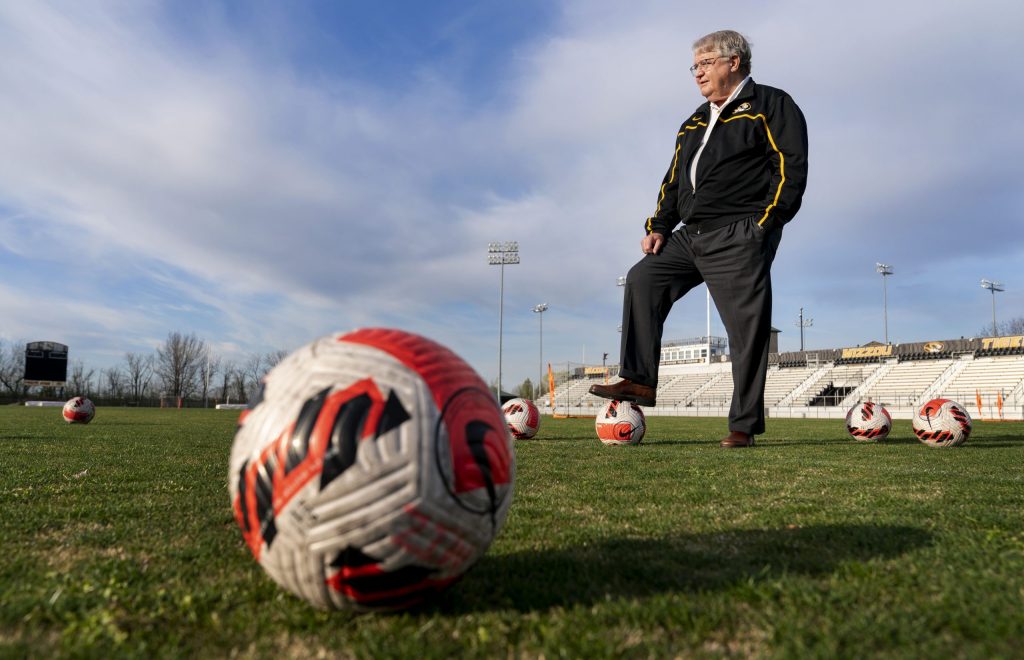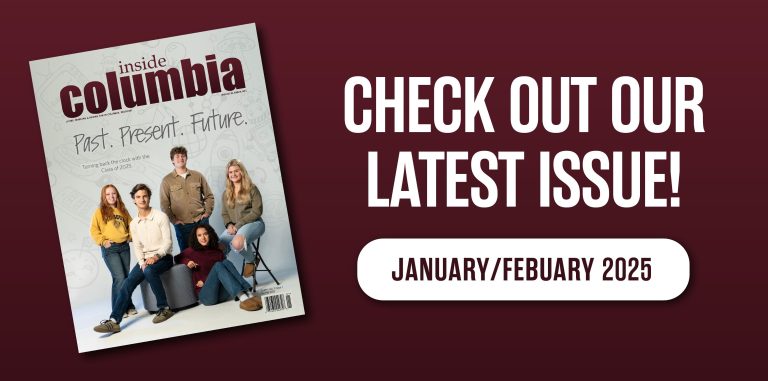Photos by L.G. Patterson
Dr. Mark Adams could have amassed an incredible autograph collection. But he preferred collecting memories of the athletes he helped throughout his career as an orthopedic surgeon.Adams, who at age 69 practices full-time at the Columbia Orthopaedic Group, has traveled tens of thousands of miles, taken care of thousands of athletes, and contributed in his own, unique way to the success of U.S. Olympic teams as well as sports teams throughout mid-Missouri, including the University of Missouri Tigers and other Missouri colleges and high schools.
Recently, he and his wife, Carole, looked back on his career and her supporting role as a wife, mother and community volunteer. They have lived a life that most sports fans would envy.Until cutting back on his extensive volunteer work last summer, Mark spent most of his free hours and a good many weekdays away from his Columbia practice, on fields and in locker rooms as a physician for a wide variety of teams, competing at all different levels of play.
Among the high points of his career were the years he was chosen as a physician for the United States Olympic team. While serving in this capacity, he accompanied Team USA to the 1996Atlanta Games and 2000 Syndney Games. Also from 1995-2002, he served as team physician for the U.S. Soccer Women’s National Team, and was on the field for the team’s famous 1999 World Cup victory. Closer to home, the Mizzou Athletic Department relied on his medical skills and commitment to athletes for 32 years.
Physicians who are chosen to support Olympic teams are among the most accomplished and respected in their field of practice. Mark, like the other team physicians, went through a vetting process that has been described as “grueling.” In addition to being highly skilled and knowledgeable, team physicians must have a personality and character that can gain the trust of athletes and trainers. Mark takes his accomplishments in stride.“That’s just what sports medicine doctors do,” he says. “We all love sports and helping take care of athletes’ injuries.”
While some doctors pride themselves on how quickly they can rush patients in and out of their examining room, Mark has a different approach. He spends so much time talking with his patients that on many days he runs behind schedule. But he doesn’t mind. “What I enjoy most is being around people. I really enjoy my patients and athletes, and that’s why I’m still practicing,” he says.
Sarah Reesman, a founder and current board member of Columbia’s Women’s Intersport Network, (WIN) has known Mark for years. Like most people who know him well, she considers him a friend. “He’s just one of those people who you feel comfortable with right away. His abilities as an orthopedic surgeon are as highly valued as is his compassionate manner of relating to people,” she says. WIN in Columbia recently presented Mark with the Ken Heitholt MemorialAward, recognizing his contribution to women’s sports.
Mark and Carole describe their family as a “sports family.” Not only do they love watching sports, but when their four children were still in school,Carole assumed the role of family chauffeur, driving kids to sporting events around town and to other cities. “There were times when I felt I had little time for anything other than getting the kids to and from practice,”she says. Because their children were on various select teams, they might need rides to four different cities on the same day. Scheduling who took who to where required a lot of coordination with other parents while Mark was away. “When I was gone — and I might be in Russia for six weeks or Australia for a couple. months — the burden of taking care of the kids all fell on Carole,” Mark says. “She always kept the home fire going.”
With four kids in school, Carole only occasionally was able to meet — or at least see — her husband while he was on the sidelines of fields around the world.Even if she flew in for a quick visit, there were obstacles.
One time, she brought the kids with her to visit Mark at an Olympics practice in Orlando, Florida. She and the kids hadn’t seen Mark for six weeks and because of security measures, Mark and the team spent their nights in a heavily guarded area. As Carole approached the field, a couple of FBI agents swooped down on her. “They had huge guns,” Carole says. “I told them I was there to see my husband, but they wouldn’t let me through. I was able to wave to Mark, but that’s all.”
Mark wasn’t always isolated under such a high level of security, and one ofCarole’s favorite memories was going to after-parties where she and the kids met the World Cup Women’s Soccer team and their families. “They were really down to earth — people just like you and me,” she says
When their daughter, Caitlin, was 9 years old, Carole and Mark planned a weekend in Chicago where she could spend some time with Mark. When the Women’s Soccer Team learned that his daughter was coming for a special weekend, they insisted that Caitlin spend the night with the team. In the weeks that followed, Mia Hamm, star forward of the team, called their home in Columbia a couple times to check with Mark about some training issues.
“Caitlin would get on the phone a few minutes, and thinking Mia was calling just to talk to her, would thank her for calling before Mia would ask for me,”Mark says. Although Olympic and World Cup athletes are an elite breed of individuals, Mark provides the same level of care and concern to high school, college or recreational teams. Bryan Blitz, who coached Mizzou’s women soccer teams for 25 years, relied on Mark’s expertise to care for his student athletes. Over the years, the two became close friends, professionally as well as personally. Blitz admires Mark’s unassuming approach to life. “His skill as a surgeon and in sports medicine is recognized all over the world — but he’s the humblest person you’d meet. He doesn’t like totalk about his accomplishments.”
For Mark, being a team physician brings two of his favorite things together— people and sports. “When you’re on the sidelines, you’re there in a double capacity,” he says. “First, you’re there working, trying to make sure nothing bad happens, and if there is an injury, you can evaluate it immediately to determine whether the athlete can keep playing or not. And you’re also there as a sportsman, loving what you do.”
There’s much more to sports medicine than treating torn ligaments or other injuries. At high-stakes competitions, such as the Olympics, even an upset stomach can set off an alarm for team physicians. “You’re at DEFCON 5, most of the time,” Mark says. “Once the roster is set, you don’t get to easily replace players listed on that roster. A pre-game stomachache may require you to rule out worse issues, such as appendicitis.”
Traveling with teams to developing nations brought another layer of complications to Mark’s role. First thing after he would land, he would check out the local hospital to determine whether the facility was one where he could confidently send an injured athlete. I fit didn’t meet his standards, he’d make backup arrangements for an airlift to another more modern facility.
At some games, he’d be part of a team of health care professionals that included a physical therapist, family practitioner and others. But there were plenty of times when he was the only physician, which meant that he’d have to attend to all the medical needs of the athletes, whether that was a cold, flu or travel-related digestion problems.
In addition to his work with athletes, Mark supports many local nonprofits, such as WIN in Columbia and the Missouri Sports Hall of Fame. Carole also takes an active role in the community, whether through her church work, her years of volunteering at schools or through helping at Room at the Inn. Bob Stull, former head coach of the MU Tiger football team, is along time friend and former neighbor of the couple. “They are both so involved in the community that they know everyone. If you go to a restaurant with them, you might have to wait a half hour to sit at your table because they are talking with everyone on the way from the door to the table,” Stull says.
Both Mark and Carole were born and raised in Sikeston, Missouri.Although they went to the same high school, they didn’t meet until Mark was already a doctor. Mark, playing on a fast-pitch softball game in Sikeston, noticed her on an adjoining field. He liked the way she swung; she liked his thoughtful, easygoing personality. Before long, they married.
Throughout their 42-year marriage, they have enjoyed taking part in various sports. Mark golfed for many years, but hasn’t been on a golf course for a while as he recovers from a back injury. He also hunts and works out at the gym.
Carole formerly enjoyed water and snow skiing, but a shoulder injury and knee problems have stopped her from enjoying those activities.
From his early days in Sikeston asa high school football player and St.Louis Cardinals fan, Mark has gone onto improve the lives and performance of athletes throughout the world. He’s one of a handful of sports medicine doctors to have been inducted into theMissouri Sports Hall of Fame. “Without sports medicine and doctors like Mark, so many people wouldn’t make it out of high school still able to compete, not to mention all the college athletes or professionals who recover from injuries,”says Jerald Andrews, former CEO and executive director of the Missouri Sports Hall of Fame in Springfield.
It’s no coincidence that Mark has had such a long history with Mizzou athletic teams. He earned his medical degree at MU before going on to his orthopedic residency in Baltimore at Johns Hopkins Hospital, followed by a sports medicine fellowship at Massachusetts General Hospital/Harvard University in Boston. Along the way, he has never lost sight of the value of sports in society. “It’s a great feature of life that helps us not only with health but also our mental health,” he says. “Obviously, this is a kind of tough world out there, and people need happy, healthy distractions.”
If gold medals were given out to people who make the world a place that’s a little less tough, Mark would have earned a place on the winner’s stand.




















